《初识李新永》
- 2021-03-01 11:42:35
- 点赞量:5984
- 点击量:106046
- 作者:郝连成 Hao Liancheng
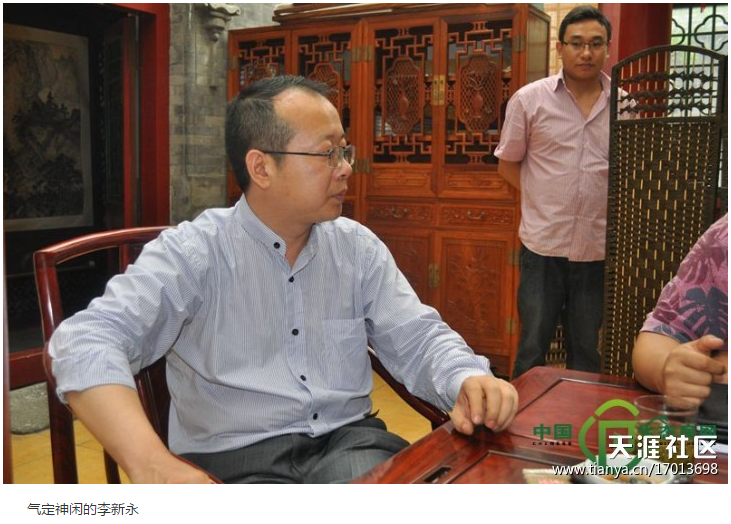
绘画好学,书法难练,有学画三五年即成绩斐然,而练书法却终生默默无闻者。盖因书法写到一-定程度没有丰厚的文化底蕴滋养和支撑再想突破难矣。
Painting is easy to learn, but calligraphy is difficult to practice. Some people who have studied painting for three or five years have made great achievements, while practicing calligraphy is unknown all their lives. It's difficult to break through because of the lack of rich cultural nourishment and support.
深通国学,以研究《四库全书》总撰官纪晓岚而著称的李新永,却因受中国传统文化影响太深而不能在书法上率意发挥而苦恼,所以他自谓戴镣铐的舞者”。这是我在纪晓岚纪念馆初识李新永后对他的总体感觉。
Li Xinyong, who is well-known for his study of Ji Xiaolan, the chief editor of Sikuquanshu, is deeply influenced by Chinese traditional culture and can't express his ideas in calligraphy. Therefore, he calls himself a "dancer in shackles". This is my general feeling about Li Xinyong after I first met him at Ji Xiaolan Memorial.
李新永是纪晓岚纪念馆的馆长,在给我的名片中还有如下头衔:中华诗词学会会员、 中国秦文化研究会艺文委员会主任、中国国家民俗协会副会长、黄胄美术基金会组联部部长、中国收藏家协会会员、北京书法家协会会员等9项头衔,从中可看出他对中国文化方面的涉猎之广。
Li Xinyong is the curator of Ji Xiaolan Memorial Hall. He also gave me the following titles in his name card: member of Chinese poetry society He has nine titles, including director of art and Culture Committee of China Qin Culture Research Association, vice president of China national folk custom Association, director of Organization Department of Huang Zhou fine arts foundation, member of China collectors association, and member of Beijing Calligraphers Association, from which we can see his extensive involvement in Chinese culture.
交流中,我还了解到李新永现在还是中国语言大学;汉学研究所研究员;客座教授,在那里他给来自世界各国的语言文学研究生讲授《纪晓岚学术与人生》。《人民日报艺术家特刊》当年曾对他有过这样介绍:
During the exchange, I also learned that Li Xinyong is still a researcher and visiting professor in the Institute of Sinology of China language and Culture University, where he teaches Ji Xiaolan's scholarship and life to postgraduates of language and literature from all over the world. People's daily artist special once introduced him as follows:
李新永祖籍河北清苑县,其父李殿云忠孝宽仁,公而无私,-生严律于己,祖父李曾于清末是京都宣武门内有名商家家境殷实多存文玩字画,至70年代李新永记事时,家境窘迫还见做中医的伯父不时抛售家藏以维生计,并把门门道出处一一讲给在侧的侄子。
Li Xinyong was born in Qingyuan County, Hebei Province. His father, Li dianyun, was loyal, filial, benevolent, fair and selfless. He was strict with himself. His grandfather, Li, was a well-known businessman in Xuanwumen, Kyoto in the late Qing Dynasty. He had a rich family and kept many books, games, calligraphy and paintings. When Li Xinyong wrote in the 1970s, he was in a poor family situation. He also saw his uncle, who was a traditional Chinese medicine doctor, selling his family collection to make a living, and told his nephew where he came from.
李新永幼承家学,在伯父中医药房启蒙学习书法幼时即深深刻下对书法、历史、文玩烙印。
Li Xinyong learned calligraphy from his family when he was young. He learned calligraphy at his uncle's pharmacy of traditional Chinese medicine. When he was young, he deeply impressed calligraphy, history and literary games.
八十年代接触并得益于启功、康殷、刘炳森等诸先生学习书法及篆刻,参加全国性书法大赛,在书坛崭露头角,十六岁时受邀为商家题写牌匾,谓已知题匾少年第一人。
In the 1980s, he came into contact with and benefited from Mr. Qigong, Mr. Kang Yin, Mr. Liu Bingsen, etc. to study calligraphy and seal cutting. He took part in the national calligraphy competition and made his debut in the calligraphy world. When he was 16 years old, he was invited to write plaques for businesses, which was the first person to write plaques.
李新永自二十岁起收集文印闲章,多年来印章数量颇丰。史上邓石如、凤六山人、潘天寿、吴昌硕、王一亭、马一浮、弘一法师、简经纶、次闲、王福厂等篆刻大家篆石皆有收藏。仅藏名家所篆印石就有三百方之多,并多年潜心研究甲骨文及古文字。虽然在纪念馆四处挂着很多李新永个性十足的书法作品,但我最关心的还是这个馆长对中国文化影响颇深的纪晓岚的评价。
Since he was 20 years old, Li Xinyong has collected a large number of seals. In history, Deng Shiru, Feng Liushan, Pan Tianshou, Wu Changshuo, Wang Yiting, Ma Yifu, master Hongyi, Jian Jinglun, CI Xian, Wang Fuchang and other seal cutting masters have collected seal stones. There are more than 300 square meters of seal stones collected by famous collectors, and they have devoted themselves to the study of Oracle Bone Inscriptions and ancient Chinese characters for many years. Although there are a lot of Li Xinyong's calligraphy works hanging around the memorial hall, what I am most concerned about is the director's evaluation of Ji Xiaolan, who has a profound influence on Chinese culture.
李馆长告诉我:《四库全书》 是纪晓岚对中国历史文化的最大贡献,此外,纪晓岚的《阅微草堂笔记》也不能小觑。因为四库全书是在前人的史书基础上整理、考证编撰的。而《阅微草堂笔记》则蕴含了纪晓岚自己的治理思想和对社会的责任感对后世后学的教化理念。
Curator Li told me that Sikuquanshu is Ji Xiaolan's greatest contribution to Chinese history and culture. In addition, Ji Xiaolan's Yuewei thatched cottage notes can not be underestimated. Because Sikuquanshu is compiled on the basis of previous historical books. The notes of Yuewei thatched cottage contains Ji Xiaolan's own governance thought, sense of social responsibility and educational idea for later generations.
在满屋明清书柜和摆满《四库全书》的客厅,李新永边饮着飘着清香的铁观音边文语细声地讲述着。此时的李新永身着细蓝条纹衬衫,睿智的额头加上一副浅边眼镜,更加透出了他的文静和儒雅。
In the room full of Ming and Qing Dynasty bookcases and the living room full of Sikuquanshu, Li Xinyong drinks Tie Guanyin, who is fragrant, and talks in a soft voice. At this time, Li Xinyong was wearing a thin blue striped shirt, a wise forehead and a pair of shallow glasses, which further revealed his quiet and elegant.
纪晓岚一生,有两件事情做得最多,一是主持科举,二是领导编修。他曾两次为乡试考官,六次为文武会试考官。先后做过武英殿纂修官、三通馆纂修官、功臣馆总纂官、国史馆总纂官、方略馆总校官、四库全书馆总纂官、胜国功臣殉节录总纂官、职官表总裁官、八旗通志馆总裁官、实录馆副总裁官、会典馆副总裁官等。
Ji Xiaolan has done two things most in her life. One is to preside over the imperial examination, the other is to lead the compilation. He has been an examiners for the rural examination twice and the civil and military examination six times. He has been the compilator of wuyingdian, santongguan, gongchenguan, guoshiguan, fanglueguan, Sikuquanshu, shengguogongchenxianjilu, zhiguanbiao, baqitongzhi, Shilu, Huidian, etc.
虽然做这些总纂官都是编辑前人的典籍,但纪晓岚在政治上也有自己的主张。他认为,“教民之道,因其势则行之易,拂其势则行之难"。主张“酌乎事势”,“趋利避害”。
Although these chief compilers were all editors of ancient books and records, Ji Xiaolan also had his own views on politics. He believes that "the way to teach the people is easy because of its potential, but difficult because of its potential.". He advocates "taking into account the situation" and "pursuing advantages and avoiding disadvantages".
李新永认为在纪晓岚身上最值得弘扬和传播的是他廉政。纪晓岚- -生历任编修、左庶子、福建学政、兵部侍郎、左都御史、礼史、兵部尚书、协办大学士、加太子少保等,最后是朝庭的一品大员。相当于现在的国务委员和副总理级别了,但在他死后嘉庆皇帝去吊唁时,纪家连买吊唁的白布银子都拿不出来了,还是嘉庆特批500两银子办理了丧事,联想到当下一个小乡长都有上百万的贪腐现象,李新永现出了一脸的感慨:人心不古,人心不古啊。
Li Xinyong believes that Ji Xiaolan's honest government is the most worthy of promotion and dissemination. Ji Xiaolan was a senior member of the imperial court. He was a senior editor, Zuo Shuzi, Fujian Xuezheng, Minister of the Ministry of war, zuodu Yushi, Li Shi, Minister of the Ministry of war, assistant bachelor, jiataizi Shaobao and so on. It's equivalent to the level of State Councilor and vice premier now. But when Emperor Jiaqing went to mourn after his death, the Ji family couldn't even buy the silver for mourning. Jiaqing approved 500 taels of silver for the funeral. Thinking of the millions of corruption in a small township head, Li Xinyong expressed his emotion: People's heart is not ancient, people's heart is not ancient.
纪晓岚不仅在金钱上不贪,就是在名上也非常低调。李新永指着满架的《四库全书》说:“纪晓岚认为自己的作品超不过古人,所以不重著述,不存作品。纪晓岚的门生刘权之就说他老师文名满天下,经常给人写文,但都“随手散失,并不存稿”,原来纪晓岚总是认为这些文字不过是古人的糟粕而已,没有刊刻的价值。纪晓岚的另一门生陈鹤也说,老师自从主持纂修《四库全书》,纵观古今著述,知道该有的都已经有了,后来的人再怎么挖空心思,所著也不出古人的范围,而那些自谓超过古人的人,都是自不力罢了。”“这样大学问的人都认为自己所著超不过古人,你再看当代的人,连汽车站牌都认不全的人就想写《月子》。是不是有些太可笑了,当代人的浮躁到处可见。” 听李新永讲到这里时我好像一下子明白了 他为什么自号镣铐舞者”因为他对中国的文化-直存在一种敬畏之心。
Ji Xiaolan is not only not greedy in money, but also very low-key in name. Li Xinyong pointed to the full shelf of Sikuquanshu and said: "Ji Xiaolan thinks that his works can't surpass the ancients, so he doesn't pay attention to writing, and there are no works. Liu Quanzhi, a student of Ji Xiaolan, said that his teacher's articles are famous all over the world and often write to others, but all of them are "lost at random and do not keep manuscripts". It turns out that Ji Xiaolan always thinks that these words are just the dross of the ancients and have no printing value. Chen he, another student of Ji Xiaolan, also said that since the teacher presided over the compilation of Si Ku Quan Shu, looking at the ancient and modern works, he knew that there were already some. No matter how much later people tried, they couldn't find out the scope of the ancients, and those who said they were better than the ancients were just helpless. " "In this way, people in universities think that their works can't surpass the ancients. If you look at contemporary people, people who can't even recognize the bus stop sign want to write yuezi. Isn't it ridiculous that the impetuosity of contemporary people can be seen everywhere? " When Li Xinyong talked about this, I suddenly understood why he called himself "shackle dancer" because he had a sense of awe for Chinese culture.
他认为中国的文化博大精深,后人所有的研究都是在前人基础上的零打碎敲和修修补补。在哪个领域都还没有出现过"集大成者”。农事研究有超过《齐民要术》的吗?军事研究有超过《孙兵法》的吗?水利研究有超过《水经注》的吗?医药研究有超过《黄帝内经》和《本草纲目》的吗?现代人生活水平高了,也有了闲钱和时间到处游玩和旅行,但哪有超过《徐霞客游记》的。就说中国最传统的书法吧,本来古人造字是为了记事,传递信息和表达感情,那么第一个标准就是得让别人认识。所以中国的文字遵循的是形、声、意三个主要原则。而现代有些书法界人士则把书法弄得乎又玄,绑架了书法艺术,把书坛搞成了少数人垄断的扬名聚财阵地。李新永认为中国最具美感和能表达出象形的字当首推秦后的小篆。
He believes that Chinese culture is extensive and profound, and all the research of later generations is piecemeal and patchy on the basis of predecessors. In any field, there has never been a "synthesizer". Is there any agricultural research that surpasses QiminYaoshu? Is there any military research that surpasses sunbingfa? Is there any water conservancy research that surpasses shuijingzhu? Is there any medical research that surpasses Huangdi Neijing and compendium of materia medica? Modern people have higher living standards, and they also have spare money and time to play and travel everywhere, but none surpasses XuXiake's travels. Let's talk about the most traditional Chinese calligraphy. Originally, the ancients created characters to remember events, convey information and express feelings. Then the first standard is to let others know. Therefore, Chinese characters follow the three main principles of form, sound and meaning. However, some modern calligraphers have made calligraphy mysterious, kidnapped the art of calligraphy, and made the calligraphy world a monopoly of a few people. Li Xinyong thinks that the most beautiful and pictographic character in China is Xiaozhuan.
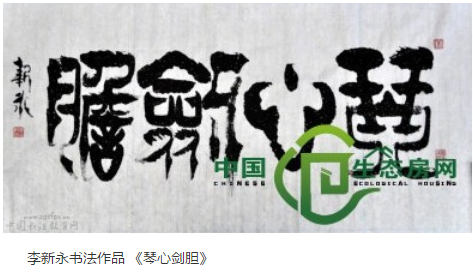
李新永写书法三十多年,其书法以篆隶结体,由印文入书,世人多称刀马篆,字体追显金及石铭文风格,苍劲古朴又挥洒淋漓,快驰钝慢敛张有度,书艺娴熟纯深,每字都蕴涵音乐之律境,款字行书更见颜体风骨。他的书法以篆、隶结合见长,取历史上大家之长,融篆隶于一体,在布局.上疏密相间,虚实结合。线条上粗细并用,方圆交替。笔法多用回、藏、顿、挫使作品尽显苍劲连绵自如奔放。给人以古朴中求新,奋然向上的感觉。中锋用笔更是独到传神,笔锋果断线条张挺而富于变化规范的篆隶结体显示着他对传统文化的遵循,线条的张挺变化透出了他对书法的创新追求。字如其人,从他的作品中能感觉出其为人的儒雅、谦和。从他满身书卷气中就能知道这是个潜心学问、专攻学术的学者型馆长。交流中他的助手介绍李馆长的学术文章和书法作品多发表于书籍报纸和杂志。其创作书法作品《十二生肖》深受国内外书法收藏家的喜爱。近年来不断收到海外华人社团邀请,到国外去进行中国传统文化交流和书法展览。据了解李新永的书法作品多次被国家外交部作为礼品赠送给外国政要。很多到纪晓岚纪念馆参观的中外游客也都能为收藏到李新永的书法作品而感到满足。就在我们采访的过程中,山西-一个文化公司的老总专程从西安赶来治谈合作,要以李新永的书法作品为主,向世界推广中国的传统文化。他说他看中的是李新永的作品能表现出真正的传统文化。
Li Xinyong has been writing calligraphy for more than 30 years. His calligraphy is based on the combination of seal and official script, which is called Dao Ma seal in the world. The style of calligraphy is gold and stone inscriptions. The style of calligraphy is vigorous, simple and elegant. His calligraphy skill is skillful and pure. Every word contains the rhythm of music. His calligraphy is good at the combination of Zhuan and Li. He takes the advantages of everyone in history and integrates Zhuan and Li into one. In terms of layout, he alternates density with emptiness and reality. Use both thickness and circle on the line. The technique of writing is often used to return, hide, pause and frustrate, which makes the works full of vigor, continuity and freedom. It gives people the feeling of seeking novelty and striving upward. The center's pen is more original and vivid. The strokes are decisive, the lines are Zhang Ting, and the standard structure of Zhuan and Li show his adherence to traditional culture. The changes of the lines reveal his innovative pursuit of calligraphy. From his works, we can feel his elegance and modesty. He is a scholarly librarian who concentrates on learning and specializes in learning. During the exchange, his assistant introduced curator Li's academic articles and calligraphy works, which were mostly published in books, newspapers and magazines. His calligraphy work twelve zodiac is very popular among calligraphy collectors at home and abroad. In recent years, we have been invited by overseas Chinese associations to go abroad for Chinese traditional cultural exchanges and calligraphy exhibitions. It is understood that Li Xinyong's calligraphy works have been presented to foreign dignitaries as gifts by the Ministry of foreign affairs for many times. Many Chinese and foreign tourists visiting Ji Xiaolan memorial hall are also satisfied with the collection of Li Xinyong's calligraphy works. In the process of our interview, the general manager of a culture company in Shanxi province came from Xi'an to discuss cooperation. We should focus on Li Xinyong's calligraphy works and promote Chinese traditional culture to the world. He said that what he saw was that Li Xinyong's works could show real traditional culture.
李新永(右)在向笔者讲述纪晓岚与中国传统文化正像《人民日报》介绍的那样,李新永确实对中国文化名人的印章很有研究,聊到这里他给我们展示了部份收藏,使我大开了眼界。在这里我看到了钱君陶、高野候、李叔同(弘一大法师)、吴昌硕、潘天寿等清至民国时期文化名人的印章。知道了这些印章轶闻传说。像当时的治印大家一粟道人,陈巨来等只刻字就需20个银元。李叔同的印章材质就是红白中透着红润的高山玛瑙红,用手摸去有种羊脂玉一样的温润感觉。
Li Xinyong (right) is telling the author about Ji Xiaolan and Chinese traditional culture. Just as the people's daily introduces, Li Xinyong does have a lot of research on the seals of Chinese cultural celebrities. Here he shows us some of his collections, which broadens my horizons. Here I see the seals of Qian Juntao, Gao yehou, Li Shutong, Wu Changshuo, Pan Tianshou and other cultural celebrities from the Qing Dynasty to the Republic of China. Know these seal anecdotes. For example, at that time, it took only 20 silver dollars for Chen julai and others to engrave. The material of Li Shutong's seal is red and white with a ruddy mountain agate red. When you touch it with your hand, you can feel the warmth of a kind of suet jade.
听完李新永讲述对纪晓岚客观评价,再看了李新永的这些印章收藏,我好像理解了他的书法风格和来历,也更加感觉到了他的书法作品将来在中国传统文化传承中的重要价值。
After listening to Li Xinyong's objective evaluation of Ji Xiaolan and looking at Li Xinyong's seal collection, I seem to understand his calligraphy style and origin, and also feel the important value of his calligraphy works in the future in the inheritance of Chinese traditional culture.
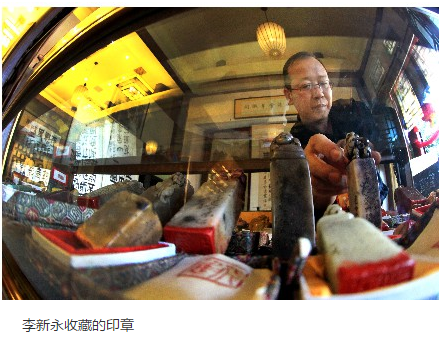
郝连成2013年5月采写于纪晓岚纪念馆
Hao Liancheng wrote in Ji Xiaolan Memorial Hall in May 2013


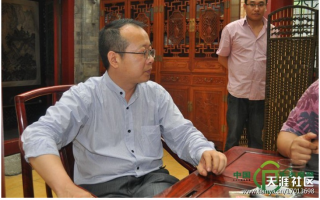
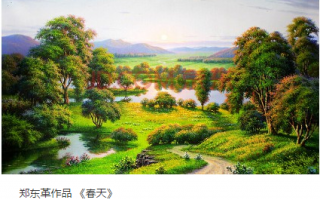

雁在蓝天